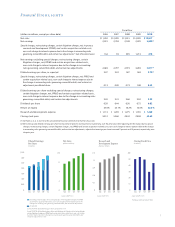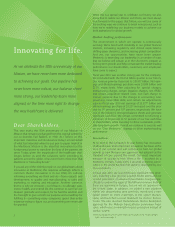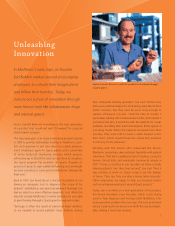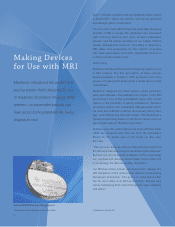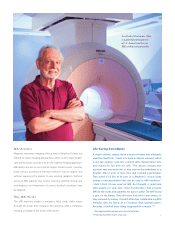Medtronic 2010 Annual Report Download - page 9
Download and view the complete annual report
Please find page 9 of the 2010 Medtronic annual report below. You can navigate through the pages in the report by either clicking on the pages listed below, or by using the keyword search tool below to find specific information within the annual report.
their infrequent fainting episodes,” Lee said. “At the time,
there were external diagnostic tools being used, like 24-hour
Holter monitors, but they can’t be worn long enough to
capture infrequent syncope. I had the idea to modify a
pacemaker, adding self-contained electrodes, and implant it
just below the skin. It would be with the patients for a year,
endlessly recording their electrocardiogram (ECG) signals in
a looping mode. When the patients recovered from their
syncope, they were told to wave a small magnet across
their chest, which would freeze the critical ECG evidence
in memory for the physician.”
Working with the doctor who requested the device,
Medtronic researchers demonstrated feasibility with patient
volunteers. That led to additional Quest funding, successful
human clinical trials, and eventually commercial release in
1997. “It was so exciting to see my idea out there actually
helping patients turn their lives around,” Lee said. “And it
was exciting to work on. Quest projects are like badges
of honor. They say, ‘Hey, my idea is being taken seriously.’
Other employees are eager to help you because there’s
such an entrepreneurial spirit around Quest projects.”
Today, Lee is working on a next generation of his product,
the Reveal Insertable Loop Recorder, which is also being
used to help diagnose and manage atrial fibrillation, a far
more prevalent problem than syncope. The next-generation
device is planned to be about one-tenth the size and inject-
able, making it much less invasive.
Unleashing
Innovation
In Medtronic’s early days, co-founder
Earl Bakken walked around encouraging
employees to unleash their imaginations
and follow their hunches. Today, we
nurture our culture of innovation through
more formal tools like collaboration blogs
and internal grants.
Senior Scientist Brian Lee is working on the next generation
of a product that would not exist if it weren’t for a special
internal grant program.
The Quest program is an internal venturing program started
in 1989 to provide technology funding to Medtronic scien-
tists and engineers to test new ideas for possible advance-
ment. Employees apply for Quest grants, and a committee
of senior technical employees chooses which projects
will receive up to $50,000 in seed money. Since its inception,
the Quest program has awarded 165 grants. Roughly 25
percent of projects gain additional funding and eventually
become a product or some part of a Medtronic therapy, like
Brian Lee’s.
Back in 1989, Lee heard about a doctor’s frustration at not
having an adequate tool to diagnose the cause of his
patients’ debilitating syncope (unexplained fainting). Lee
had an idea for a more effective diagnostic tool. While the
idea fell outside Medtronic’s normal activities, he was able
to gain funding through a Quest grant to explore his idea.
“Syncope is often the result of abnormal heart rhythms,
so we needed to record patients’ heart rhythms during
Senior Scientist Brian Lee with the product he developed through
a Quest grant.
5





